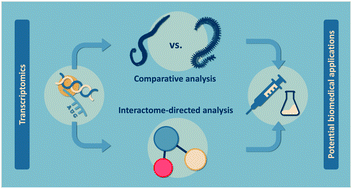A drug discovery approach based on comparative transcriptomics between two toxin-secreting marine annelids: Glycera alba and Hediste diversicolor†
Abstract
Most animal toxins evolved to interact with specific molecular targets, which makes them highly-prized bioactives for drug development. Marine toxins, in particular, due to their wide chemical diversity, offer a new range of possibilities, a few of which have already been translated into approved drugs. Glycera alba and Hediste diversicolor are sympatric Polychaeta with distinct ecology and behavior suspected to secrete toxins that evolved to interact with distinct molecular targets, thus with differential selectivity and potential applications in drug discovery. Comparative transcriptomics revealed that while G. alba's venom apparatus is localized in the proboscis and neurotoxins are secreted to overtake prey, H. diversicolor secretes fewer and less specific toxins that are seemingly a defense. Human interactome-directed analysis unraveled novel toxins and other bioactives with potential biomedical applications, like proteins from G. alba's venom that can regulate apoptosis, whereas H. diversicolor yielded proteins that may control inflammation and cell proliferation in humans. Omics and bioinformatics appear to be powerful tools for marine bioprospecting and drug discovery, enabling molecular mining through transcriptomes of non-model organisms and link their ecology and physiology with protein's specificity and bioreactivity. Interactome-directed analysis against the human proteome seems an efficient alternative to the design of synthetic drugs.



 Please wait while we load your content...
Please wait while we load your content...